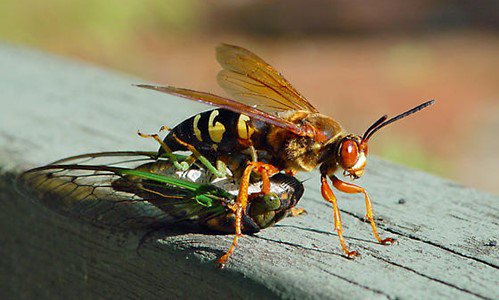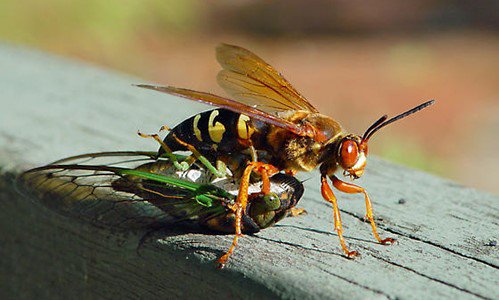Growing up I was always interested in all types of insects, except fire ants of course. So much so that I became an entomologist.
However, I know many people aren’t quite as interested in bugs and can get pretty excited about insects we see outside.
Most insects are harmless or easily managed. Here is some information about insects we are getting around Coastal Georgia this time of the year.
What are these very large yellow and black wasps I see digging holes in my garden?
These wasps are probably cicada killer wasps.
These narrow-waist wasps are black and have yellow markings on their sides and abdomen. Their legs have yellow on them as well. The most remarkable thing about them is their size – up to 1 5/8 inches long.
They do not pose much of a threat to humans.
They can sting but are unlikely to do so unless you bother them. Cicada killer wasps do attack cicadas though. Cicadas are the large insects that sing in the tops of the trees in the summer. The cicada is about 1 1/8 inches long with clear wings up to 3 inches long.
They are stout bugs and are black to brown with large bulging red eyes, red legs and a red-brown to yellow belly. The wings may have some orange in them.
Cicadas look scary but they are even less dangerous than the wasps. They will not harm you. They do not have a stinger or biting mouthparts. Be careful when handling them since they do have some sharp parts on their bodies.
Predators love cicadas because they are large and easy to catch. Cicada killer wasps use the cicadas as food to raise their young.
The female wasps dig shallow holes in the soil as a nursery for their young.
They hunt for and catch cicadas and then stun them with a sting and carry them to their nest. Carrying a cicada is a difficult job for a wasp. Cicadas are big and heavy!
The wasps carry the cicada to the top of something tall. Then they launch themselves and their burden from there. They glide towards the place where they have dug their hole. Then they climb again and repeat the process until they get their burden to the hole.
Once they get to the nest, they lay an egg on the paralyzed cicada. After the egg hatches, the young wasp feeds on the cicada, makes a cocoon and over winters until next year.
Then the new cicada killer wasp emerges to begin the process again.
Cicadas and these wasps are not extremely harmful – but they are interesting.
They are designed and created in a fascinating way.
Enjoy this exciting drama going on in your garden.
What is this caterpillar eating all the leaves off my
azaleas?
Azalea caterpillars are another pest to look out for here in our neck of the woods. These pests are true to their name and are caterpillars that feed on azalea leaves.
They often feed together, especially when young. This large caterpillar has a red head and legs with rows of yellow spots and a few white hairs. When disturbed, they may arch their heads and tails backwards.
If you only have a few caterpillars, pick them off and crush them. If there are too many for this, you can spray them with liquid Sevin, cyfluthrin or other appropriate insecticide.
Read and follow all label directions.
A few caterpillars may not hurt anything but many can strip an azalea of all its leaves. Bacillus thuringiensis (B.t. – Dipel, Thuricide and others) sprays may work if the caterpillars are small. B.t. is less toxic to people than traditional insecticides.
If you are unsure if an insect is helpful or harmful reach out to me at the Bryan County Extension office, chances are I can help you ID and manage whatever insect is troubling you. Send any pictures you can get to uge3029@uga.edu or call at 912-653-2231.

